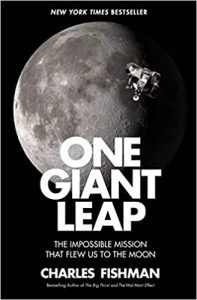I have totally enjoyed One Giant Leap: The impossible mission that flew us to the moon, by Charles FIshman, out now as a paperback. It covers everything about the Apollo mission, from the Cold War context (the shock of Sputnik and Gagarin) and JFK’s political calculations and Congressional debates, to the practicalities of the science, design and manufacturing, to the lasting consequences for global society. The Soviet lead in space stimulated the US space effort, but Kennedy himself was lukewarm about America being first on the Moon. Fishman argues that the assassination of the President ensured the continuation of the mission because it became a memorial to him.
One key long-term consequence is that the mission to get humans on the moon brought about the digital revolution. Fishman makes a totally persuasive case that NASA was such a large-scale and demanding, perfectionist purchaser of integrated circuits that it ensured they became faster, more reliable and cheaper with every passing year. Transistors had only been around for 10 years but were too large and power hungry for the new performance demands of manned space flight. NASA bought most of the chips made in the US during the 1960s. The first ones cost $1000 each, in 1962 they were under $100 each, in 1963 $15 each and $7.68 by 1965.
The other long-term impact was to turn ‘technology’ from something scary and Dr Strangelove-like to do with nuclear weapons and mutually assured destruction into something benign and aspirational, the challenge of conquering space for all humanity, albeit planting US flags on the Moon. “The race to the Moon … invoked the wonders of science, with about as much drama as could be imagined.”
The sections about managing the huge engineering project across multiple suppliers, manufacturing to the essential high standards, obessing over details, making key design decisions are all totally fascinating. MIT’s Instrumentation Lab was writing all the software – itself a new word in the early 1960s – and this threatened to delay the launch beyond Kennedy’s ‘before the decade is out’ deadline, so complex and crucial was the task. “It was the first of a whole new kind of engineering projects,” Fishman writes. There was no prior know-how about how to run these. Indeed, big, complex software engineering projects all too often still go wrong. Humans got to the moon and safely back because of the attention to detail on the part of NASA engineers.
The Apollo project was made all the harder by the fact that the onboard computer had to fit within one cubic foot, and its memory contained just 589,824 0s or 1s. So its software was – literally – woven by hand. MIT and NASA HQ had tapes and punch cards. On the spacecraft itself, the programs required to get to the Moon, land the Lunar Module, take off again, dock in space with the Command Module, and return to Earth, there was no room for these bulky items. The punch cards were taken to an old textile factory in Waltham, Massachussetts, where women who had woven fabric, or manfactured watches, in previous jobs now wove software into ‘core rope memory’ at special looms. Their old skills made them the only kind of workers with the know-how to weave computer memory. When the women struck for a while in the mid-1960s, everything their supervisors and managers produced until the strike was over, had to be scrapped.
This is the kind of detail that made me love the book. But the wonder of the Apollo Mission is also part of the enjoyment. I have a vague memory of watching Neil Armstrong, sitting in my PJs along with my older siblings; our family had got our first TV for the occasion. I ended One Giant Leap feeling vaguely optimistic as we approach the end of a dreadful year. Human societies can do impossible, wonderful things, with a combination of political vision and support, and engineers.

